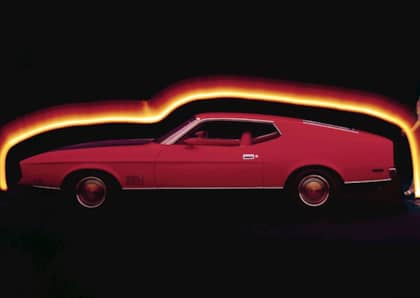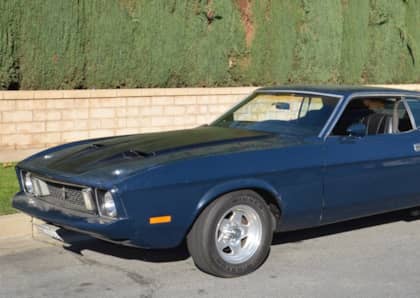The Ford 351 V8 Came In Cleveland, Windsor, and Michigan (Modified) Flavors
There are few engine families as confusing as the Ford 351 V8. Starting at the end of the 1960s, Ford produced no less than three different versions of this classic eight-cylinder, sprinkling them over nearly its entire lineup of cars and trucks. By the time the final 351 was sold in the late '90s it had been split into Windsor, Cleveland, and Michigan (or Modified) camps.

For anyone who's had to identify which parts fit and which ones don't on their particular flavor of 351, the struggle of dealing with this small block eight-cylinder is real. At the same time, the benefits associated with one of Ford's longest-lasting engine designs are plentiful, with thousands of hot rods, cruisers, and off-roaders relying on the 5.8L V8.

What are the differences between 351W, the 351C, and the 351M? The history of this trio of V8s is as interesting and varied as the vehicles they powered for more than 30 years.
A Bigger Small Block
The origins of the 351 are simple enough. At the end of the 1960s Ford was seeking a way to increase the torque produced by its 302 cubic inch V8 without having to spend a lot of money developing a new engine. The answer was to increase the stroke and bump displacement by nearly 50 cubes, giving the 351 the first part of its name. The second—Windsor, or 'W'—referred to the Ontario engine plant where it was built.

Side-by-side, it's the 351W's taller block that gives it away when compared to the more common 302, as well as the water pump housing cast directly into the front of the block. In addition to changing the firing order, Ford also strengthened the block casting to improve reliability given its higher power output, and so the engine quickly became a favorite among the performance crowd (with earlier, pre-1974 blocks offering an extra 25 lbs of metal compared to those that followed). Originally, the compression ratio was a healthy 11.0:1, although this number would fall to 8.8:1 once EPA regulations took effect later in the 1970s.
The 351W delivered on its torque promise, in part thanks to a head design that focused output lower in the rev range. Output would peak around 300 horsepower in the muscle car glory era, but by the 1990s the F-150 Lightning offered a fuel injected version of the motor that was good for 240 horses and 340 lb-ft of torque (thanks in part to GT40 heads that allowed for better breathing, a common upgrade on the 351W aftermarket).

8.6 million versions of the engine were built over its exceptionally long life span, and it was offered in nearly the full range of Ford vehicles, from the Mustang to the LTD to the Thunderbird to the F-Series.
High Performance, Cleveland-Style
The 351C or 'Cleveland' engine took an entirely different path to market. In fact, it wasn't related to the 351W at all, having sprung from a separate development program for what Ford called its '335' family of engines. Marrying certain features of the 385 big block (which would later spawn the 460) with a deep-breathing head design, the same-displacement 351C was wider, lower, and heavier and shared only its bore spacing and stroke with the 351W. As its name suggests it was also built at an entirely different plant (Cleveland Engine, located just outside of the titular city limits).

The free-flow, canted-valve cylinder heads installed on the 351C made it a natural for muscle car performance, and it immediately replaced the 351W in the Mustang when it appeared in 1970. Ford had learned much from the heads on the Boss 302 and many of those lessons were applied to the 351 Cleveland's standard kit.

A four-barrel 'H-code' version of the motor featured a 300 horsepower rating for 1970, followed by the Boss 351's 330 horsepower 'R-code' option the following year, and the 280 horsepower Cobra Jet (or Q-code) model that also arrived for 1971. Torque hovered around the 380 lb-ft mark.

The Boss 351 Cleveland was more special than its modest rating suggested. The engine was intended to thrive in the upper RPM range and suck in as much air as its 11.7:1 compression ratio could handle through an aluminum intake and a race-ready rotating assembly. Q-code cars were much more modest in terms of their head design and camshaft, despite the ferocity of the Cobra Jet name.

By 1972 the muscle car party was coming to a close, and the 351C only had a few years left in it. It was still possible to squeeze up to 275 'net' horsepower (versus the gross ratings of the year before) out of the engine if the H.O. version was ordered from the three available Cleveland choices, but by 1973 only the base H-code and a modest Q-code were still on the build sheet.

In addition to being sold in a Mustang wrapper, the 351C could also be had in the Ford Torino, the Mercury Montego, and the Mercury Cougar. Surprisingly, the Cobra Jet name lived on longer on the Mercury side than it did in the Mustang, associating itself with the Q-code 351 Cleveland after it had been dropped at Ford. It was also available in the mid-engine Pantera.
Michigan Or Modified?
Ford didn't abandon the 351C after it became clear that it was time to change the focus from all-out performance to a balance between power and efficiency. Instead, the Blue Oval turned to the more pedestrian 335-family V8 it had been working on since 1971, which originally debuted as a 400 cubic inch option for its larger cars and light trucks using the Cleveland motor as its basis.

The 400 featured a larger main journal and a longer stroke than the Cleveland, with a taller deck to match, and a wider intake and larger combustion chamber heads were also part of the package. Everything else matched up with the 351C's internals, which was handy in 1975 when Ford realized it was time to discontinue its entire series of FE big block engines in favor of the thriftier 351M.

The 351M was essentially a smaller 400 that made use of the same crankshaft specifications as the Cleveland (with enlarged pistons to make up for the shorter stroke), and it hit the sedan segment first before shifting to Ford trucks by the end of the decade. Compression checked in at a dreary but frugal 8.0:1, and horsepower was predictably low, settling around the 150 mark with 260 or so lb-ft of twist available (depending on which vehicle the engine was found in).

While the 'M' attached to the 351 could be taken to represent the Michigan plant where the block was cast, or the 'modified' nature of its 400-based design, officially Ford never took a stance on the name's origins. There were no performance versions of the 351M built, with two-barrel carbs and uninspiring head designs a common feature across all versions of the engine. By 1982 the engine had been retired from truck production (having already left sedans and coupes in 1979), replaced by the lighter 351W, which was also cheaper to build thanks to its commonality with the 302. Ford wouldn't deliver a new pushrod V8 until 2021's 'Godzilla' 7.4-liter motor arrived on the market.











